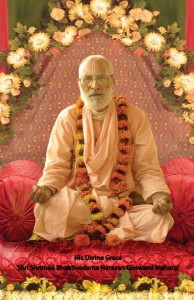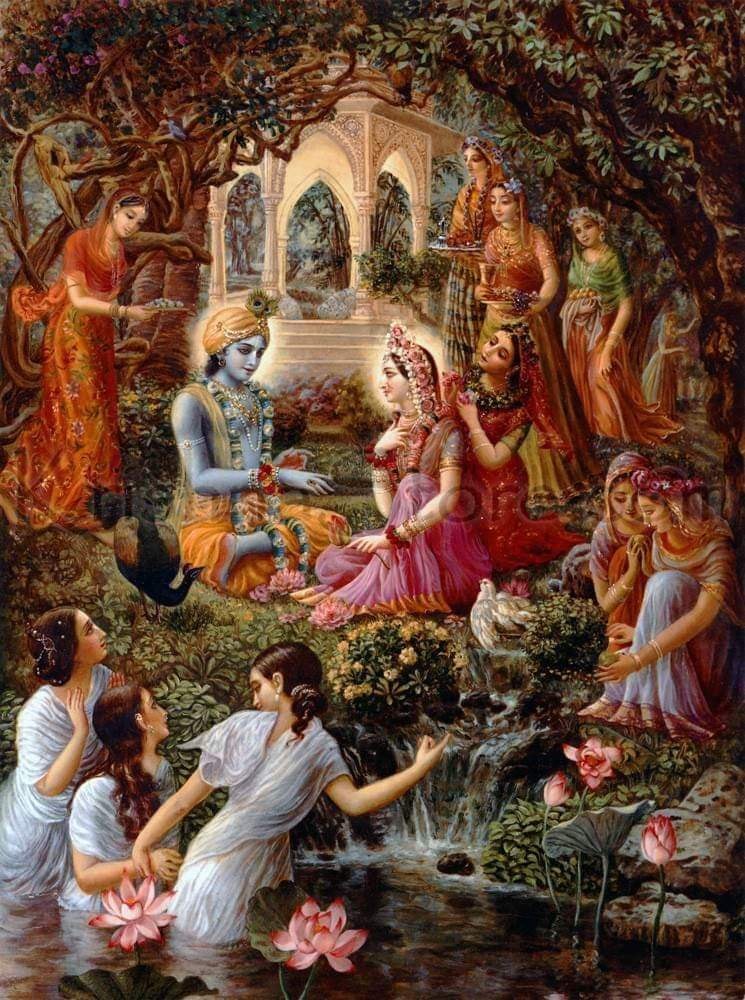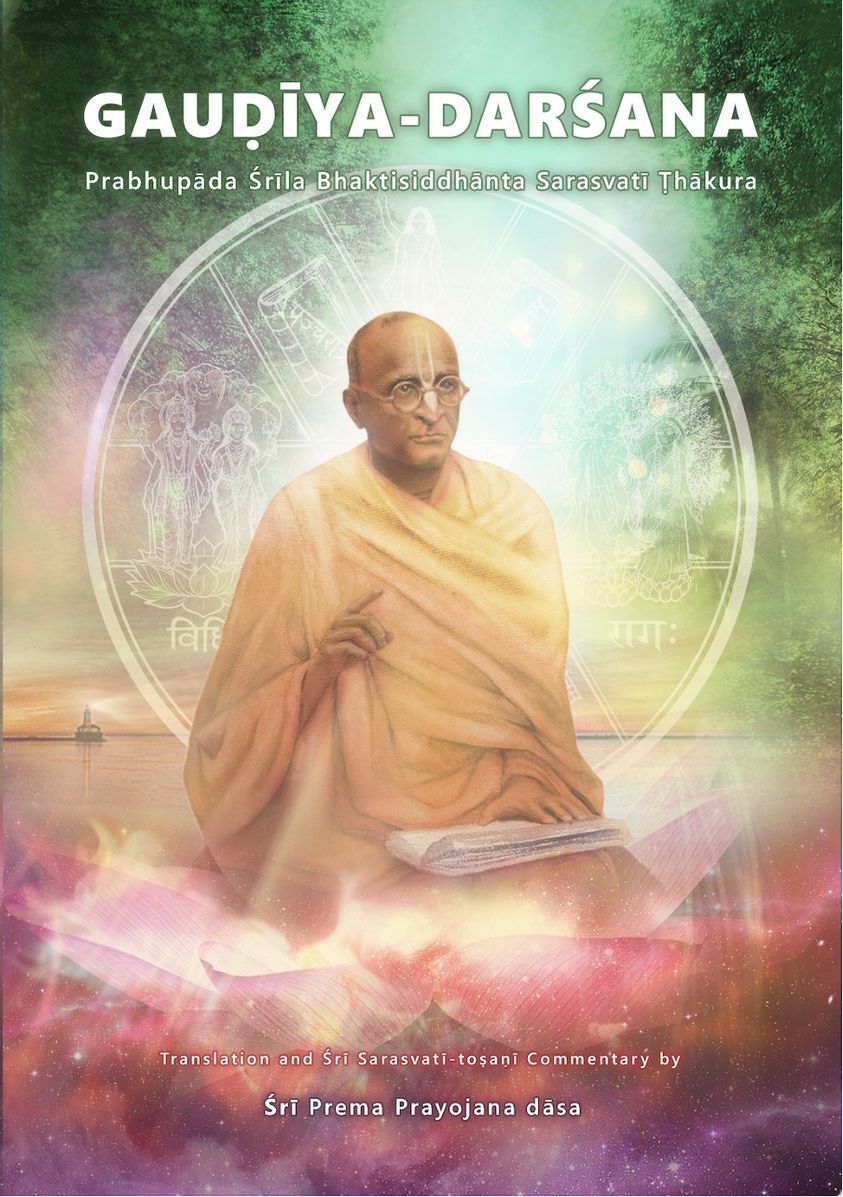
Srila Bhaktivedanta Narayana Maharaja
By adopting the conception that everything is one, the mood of service is completely destroyed. This is a very critical obstacle.

Srila Bhaktivedanta Narayana Maharaja
The highest truth is reality distinguished from illusion for the welfare of all.
By Tridandisvami Sri Srimad Bhaktivedanta Narayana Maharaja
This is a small excerpt from the lecture series called Ramananda Samvad (the Conversation Between Sri Caitanya Mahaprabhu and Sri Raya Ramananda). Srila Bhaktivedanta Narayana Maharaja giving class at Sri Krsna-Caitanya Gaudiya Matha [Jagannatha Puri, India: August 8, 2004]
Srila Narayana Maharaja
Every transcendental subject has a common symptom, and the common symptom is that it is acintya, completely inconceivable. The material mind cannot think about it. It is therefore inappropriate to apply one’s intelligence and power of material discrimination to ascertain anything transcendental.
In the scripture known as the Rg Veda, four types of purusartha (objectives) have been mentioned, namely dharma, artha, kama, and moksa. Dharma is the performance of prescribed duties recommended by the Vedic scriptures. Specifically, this comes in the form of observing the rules and regulations of varna and asrama (the social and spiritual orders). If one follows dharma carefully, the result is that he will get artha. Artha means economic development, security in this world, many servants and followers, etc. When one acquires economic prosperity, he can go to the next objective, kama. One who is materially successful can try to fulfill his material desires (kama). The fourth objective is called moksa, or liberation. Dharma, artha and kama are not actually goals of life, because those who attain these goals do not find happiness. Rather, they simply suffer.
“Purna api janana, purna api marana.” Again and again they take birth in this material world and rotate in the endless cycle of birth and death. Without exception, all living entities in this world are unhappy. Human beings, animals and other species are all unhappy. They don’t know how to find happiness. They don’t know the path to become free from suffering. All their activities simply result in pain, and if they get any happiness, it is mixed with suffering. The result of that happiness is more suffering. This is the condition of the living entities in this world. Liberation or mukti has been defined as, “adyanta dukha nivrtti,” the complete and absolute cessation of all types of suffering.
One type of mukti is called sayujya-mukti. This means that the atma will merge or enter into the impersonal effulgence (nirvesesa brahma) of the Lord, which has no qualities, no attributes, no shape, no form and no personality. In this condition there is complete cessation of all suffering, and also all happiness that is beyond material nature. So this mukti is one type of goal of life, but it cannot be called parama-purusartha, the supreme goal of life. Dharma, artha, and kama are not goals of life. Moksa may be called so, but it cannot be called the supreme goal.
Devotion to Lord Krishna is most wonderful![20101104bkmain[1]](http://www.harekrishnasociety.com/wp-content/uploads/2012/03/20101104bkmain1-300x198.jpg)
The happiness which is directly related and natural to the constitution of the living entity is called “bhagavata-seva,” service to the Supreme Personality of Godhead.
In this there are two principles. First of all, there is a particular type of relationship between the object of service, the Supreme Personality of Godhead, and His servant. Secondly there is a very intense desire to give happiness to the Supreme Lord by rendering Him service. This has been defined by Srila Rupa Gosvami:
anyavilasa sita sunyam jnana karmady anavrtam
anukulyena krsnanu silanam bhaktir uttama
The self realised guru![image002[1]](http://www.harekrishnasociety.com/wp-content/uploads/2012/03/image0021-300x199.jpg)
atmaramas ca munayo
nirgrantha apiy urukrame
kurvanty ahaitukim bhaktim
ittham-bhuta-guno harih
[“different varieties of atmaramas [those who take pleasure in atma, or spirit self], especially those established on the path of self-realization, though freed from all kinds of material bondage, desire to render unalloyed devotional service unto the Personality of Godhead. This means that the Lord possesses transcendental qualities and therefore can attract everyone, including liberated souls.” (Srimad Bhagavatam 1.7.10)]
Those who are self-satisfied (atmarama) don’t need anything in this world. They are self-satisfied. They are liberated from the clutches of the material energy and are situated on the platform of eternity. They become astonished when they hear about the wonderful, transcendental qualities of Sri Krsna, the Supreme Personality of Godhead. When they hear about His astonishing characteristics, an intense greed awakens in their hearts to serve Him. When self-satisfied personalities like Srila Sukadeva Gosvami and the four Kumaras Sanaka, Sananda, Sanatana and Sanat Kumara hear about Sri Krsna, intense greed to serve Him awakens in their hearts.
Sri Caintanya Mahaprabhu![cait01[1]](http://www.harekrishnasociety.com/wp-content/uploads/2012/03/cait011-223x300.jpg)
Lord Krsna stated in Bhagavad-gita (16.23):
yah sastra vidhim utsrjya
vartate kama-karatah
na sa siddhim avapnoti
na sukham na param gatim
“He who discards scriptural injunctions and acts according to his own whims attains neither perfection, nor happiness, nor the supreme destination.”
Those who don’t accept the conclusions of sastra, and therefore don’t follow it in their lives, cannot have happiness or success in their life. * Therefore, one should accept the conclusions of sastra with regard to understanding the goal of life and the method to attain it. If one does not follow sastra, one is bound to follow his mundane, contaminated, material intelligence. Material intelligence will mislead him and his life will be ruined. He will not be able to discover any happiness. Therefore, Sri Caitanya Mahaprabhu said to Ramananda Raya, “Please quote the scriptures to support your presentation of the goal of life.” * whatever material happiness he had is taken at death
There are many different types of scriptures: Veda, Vedanta, Upanisad, Purana, Srimad Bhagavatam and others. Among all of the different types of scriptures, Srimad Bhagavatam is best. “Srimad Bhagavatam pramanam amalam.” It is immaculate evidence regarding the ultimate goal of life.
In the beginning of their conversation, when Caitanya Mahaprabhu was posing these questions, Raya Ramananda quoted from various scriptures such as Visnu Purana and Bhagavad Gita. Each time, however, Sri Caitanya Mahaprabhu replied, “This is external; tell Me something more”. It wasn’t until Sri Ramananda Raya began to quote from Srimad Bhagavatam that Sri Caitanya Mahaprabhu began to be satisfied with his answers.
This acceptance by Mahaprabhu is also evidence that the Srimad Bhagavatam is the crest jewel of all scriptural evidence.
We see that in the impersonal light of brahman there is complete and absolute cessation of all suffering. There is some happiness; this is true. But in this type of liberation there is some obstacle, some impediment, to progress. If one wants to attain this as a goal of life, one will have to adopt the conception that “everything is one.”
By adopting the conception that everything is one, the mood of service is completely destroyed. This is a very critical obstacle. Only service to Sri Krsna can give the highest happiness. In uttama-bhakti, which is the embodiment of all happiness (rasa-svarupa), two principles are presented: the relationship between the object of service and the servant is the first, and the second is the desire to render service. These are the two prominent ingredients of rasa-mayi bhakti.
Leaving sayujya-mukti or impersonal liberation aside, there are other types of mukti: salokya, sarsti, samipya and svarupya, to reside on the same planet as the Supreme Lord, to have opulences like the Supreme Lord, to reside close to the Supreme Lord, and to have a form that is similar to the associates of the Supreme Lord. These are related to service to Sri Narayana in Vaikuntha. In these four types of liberation there is a relationship between the object of service and the servant. Here, Lord Sri Narayana is the object of service and Laksmi devi, Narada Rsi of Vaikuntha, Garuda and others are all His servants. The conception of service is present, but there is also some obstacle. Those who desire this type of liberation have some desire for their own happiness, (svasukha). Here we see that all suffering is gone and there is happiness, but something is missing. The desire to render service is contracted, restricted, and confined. It cannot totally flourish and mature.
Pure devotional service is exclusively for the happiness and welfare of Sri Krsna. For those who have one-pointed desire to give happiness to Sri Krsna, their own happiness is automatic. Their happiness lies in the happiness of Krsna, and therefore their desire to serve is intense and exclusive. It is not contracted or restricted by any desire for personal happiness or separate desires.
Therefore the goal of life of the four types of liberation is also not the supreme goal of life. Srimad Bhagavatam says in its second verse mangalacaranam (invocation):
dharma projjhita-kaitavo ‘tra paramo nirmatsaranam satam
Vedyam vastavam atra vastu sivadam tapa-trayonmulanam
Srimad-bhagavate maha-muni-krte kim va parair isvarah
Sadyo hrdy avarudhyate ‘tra krtibhih susrusubhis tat-ksanat
Srila Vyasadeva. It is described in the lists of the main avataras of the Lord as found in the Bhagavata Purana, that the seventeenth incarnation was Srila Vyasadeva who appeared as the son of Parashara Muni and his wife Satyavati. His mission was to divide the one Veda into various branches and sub-branches so the people who are less intelligent can more easily understand them. (Bhag.1.3.21 & 2.7.36)
“Completely rejecting all religious activities which are materially motivated, this Bhagavata Purana propounds the highest truth, which is understandable by those devotees who are fully pure in heart. The highest truth is reality distinguished from illusion for the welfare of all. Such truth uproots the threefold miseries. This beautiful Bhagavatam, compiled by the great sage Vyasadeva (in his maturity), is sufficient in itself for God realization. What is the need of any other scripture? As soon as one attentively and submissively hears the message of Bhagavatam, by this culture of knowledge the Supreme Lord is established within his heart.”
This Srimad Bhagavatam unequivocally kicks out all types of cheating religion; that is, any religious or so-called spiritual practices which are contaminated by material or self-centered motivation. The conclusion is that above the four types of liberation in Vaikuntha there lies Goloka Vrndavana. In Goloka Vrndavana, all the residents’ service is exclusively for the happiness of Krsna. This is their highest happiness, and this is pure and transcendental to the utmost degree. For this reason, prema, love for Lord Sri Krsna in Goloka Vrndavana, is the supreme objective of all living entities. *[see endnote] Srila Baladeva Vidyabusana explains in his commentary of Vedanta Sutra: “Muktanam api lilaya vigraham krtva bhagavtam bhajante.” Those who are liberated from this world meditate internally upon their own constitutional form (siddha-deha) their spiritual body.Externally living in this world, they meditate internally on their spiritual form, and by their spiritual form they render service to the Supreme Personality of Godhead.
Gaura Premanande!
* endnote – The supreme objective of all living entities is pure and transcendental to the utmost degree. Thus whatever objective one desires to attain in Vaikuntha, really it is completely present and included already in Goloka Vrndavana.
Editorial advisors: Sripad Madhava Maharaja and Sripad Brajanatha dasa
Translator: Sripad Aranya Maharaja; Transciber: Vrnda dasi; Typist: Jaya Sri dasi
Editor: Syamarani dasi; HTML: Bhutabhavana dasa

 Posted in
Posted in 






